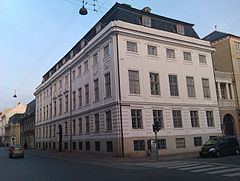Client Christen Lindencrone Construction started 1751 | Completed 1753 Opened 1753 Architectural style Rococo | |
 | ||
Similar Prince William Mansion, Barchmann Mansion, Gustmeyer House, Hansen Mansion, Mathias Hansen House | ||
The Lindencrone Mansion (Danish: Lindencrones Palæ) is a historic building located on the corner of Bredgade and Sankt Annæ Plads in central Copenhagen, Denmark. Completed in 1753, it is one of many town mansions which were built for wealthy citizens in the district Frederiksstaden in the years after its foundation in the middle of the 18th century.
Contents
- Map of Lindencrone Mansion Bredgade 26 1260 KC3B8benhavn K Denmark
- History
- Architecture
- List of owners
- References
Map of Lindencrone Mansion, Bredgade 26, 1260 K%C3%B8benhavn K, Denmark
History
Located within the new Frederiksstaden district, the mansion was built between 1751 and 1753 as a new city residence for Christen Lintrup, supercargo in Danish Asia Company, who already owned Gjorslev Manor on Stevns and was raised to the peerage under the name Lindencrone in 1756. The building was constructed by the master builder Johan Christian Conradi to a design or concept by Niels Eigtved who had also created the masterplan for the new district. Court sculptor Jacob Fortling was responsible for creating the decorations on the facade. Lindencrone rented out part of his mansion to foreign envoys.
Lindencrone's widow, Mette Holmsted, kept the property on Bredgade as her winter residence after her husband's death. Their son, Johan Friedrich Lindencrone, lived in the mansion from 1772 and took it over after his mother died in 1789. Faced with economic difficulties, he had to part with the property in 1811 after previously selling off a portion of the site to city builder Jørgen Henrich Rawert in 1794. The buyer was count Frederik Christian Raben, a widely traveled amateur naturalist, who owned the Christiansholm estate on Lolland. The Raben family owned the Lindencrone Mansion until 1840. It was then acquired by A. C. Fibiger, a manufacturer of ship sails, who built the neighbouring property at 1–3 Sankt Annæ Plads. The following owners were Caroline Fibiger, his widow, Gustav E. Broch, a lawyer, and the grocer Albert Næser.
The British State acquired the building in 1898 and it then served as the UK embassy in Copenhagen until 1980. It is now owned by Troels Holch Povlsen, the founder of Bestseller.
Architecture
The mansion is built in a restrained Rococo style and consists of three storeys and a high celler under a black mansard roof. The facade is constructed in limestone ashlars from Lindencrone's estate at Stevns.
The main facade on Bredgade is 13 bays long. It has slightly projecting central and corner bays but is brought together by a horizontal moulding along its full length above the ground floor. The projections are decorated with lesenes with square "ears", a feature often used by Eigtved, corbels and reliefs above the ground floor which in turn have horizontal grooves. The sections between the projections have shallow niches but no lesenes.
The facade on Annæ Plads is five bays long. It has niches and lesenes, which unlike those of the main facade run along the full height of the building, also on the ground floor where they carry the horizontal grooves.
